Good content doesn’t attract links naturally.
Unique content does.
You can’t make each piece you publish a linkable asset.
But a few strategically crafted linkable assets can make a huge difference for your entire website's authority.
As stated by our survey, 12% of respondents voted for linkable assets as one of the most effective link building tactics.
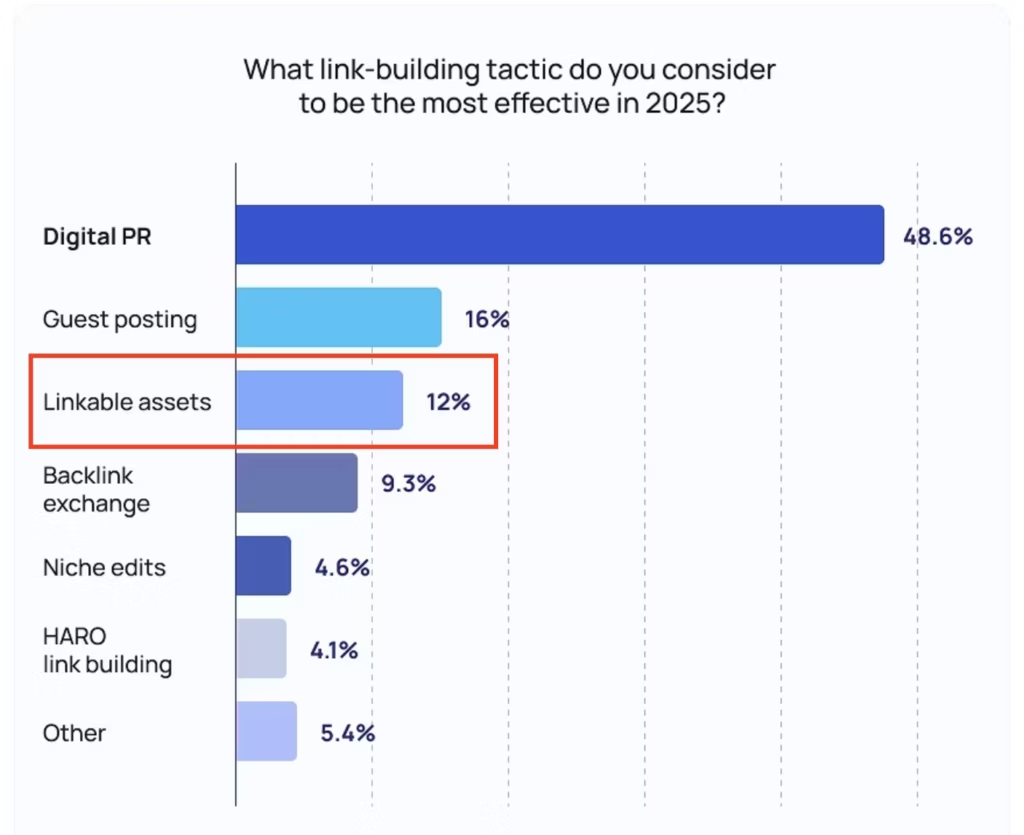
In this article, you'll discover the top reasons to invest in this resource-intensive initiative, the seven best linkable asset ideas, and how to make the most of each.
What Is a Linkable Asset?
A linkable asset, a.k.a. linkbait content or link-worthy content, is a piece of content that naturally attracts links from other resources due to its inherent value and unique perspective.
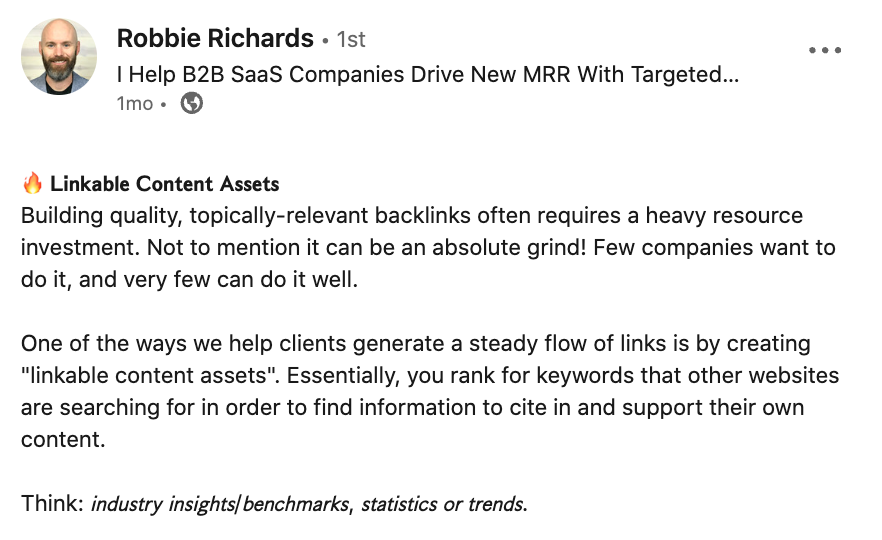
What you should know before you design one
Paradoxically, the most effective linkable assets are often those not designed to attract links in the first place.
Developing link-worthy content often starts with a different objective, like boosting brand awareness (if we talk PR) or generating leads.
These assets are typically crafted with a focus on providing genuine value, solving problems, or offering unique insights to the target audience.
Their ability to appeal to specific needs or interests within a given niche makes them highly shareable and thus, naturally attracting links from other sources.
So whatever your role in the company, it's important to work closely with your marketing team to nail down the specifics of your target audience.
What are their challenges? What information do they crave? And most importantly, what do your competitors have to offer? How do people respond to it?
Right, developing link-worthy assets requires significant effort, but nobody said it would be easy.
Define your goals first
When you present the idea to the head of marketing, they'll aim to maximize the returns on this investment, so link building will be just one of the benefits.
As I’ve already said, lead generation is the most frequent choice, but you aren’t limited to it. You may aim at increasing website traffic, improving brand visibility, enhancing authority in your industry, or generating social media engagement.
Once you've established your goals, you can tailor your linkable asset creation and promotion strategies accordingly.
Benefits of Linkable Assets
Why invest your resources in developing unique linkbait content (that might not work) when you can create several “regular” assets and build links to them?
Well, there are quite a few reasons to do it.
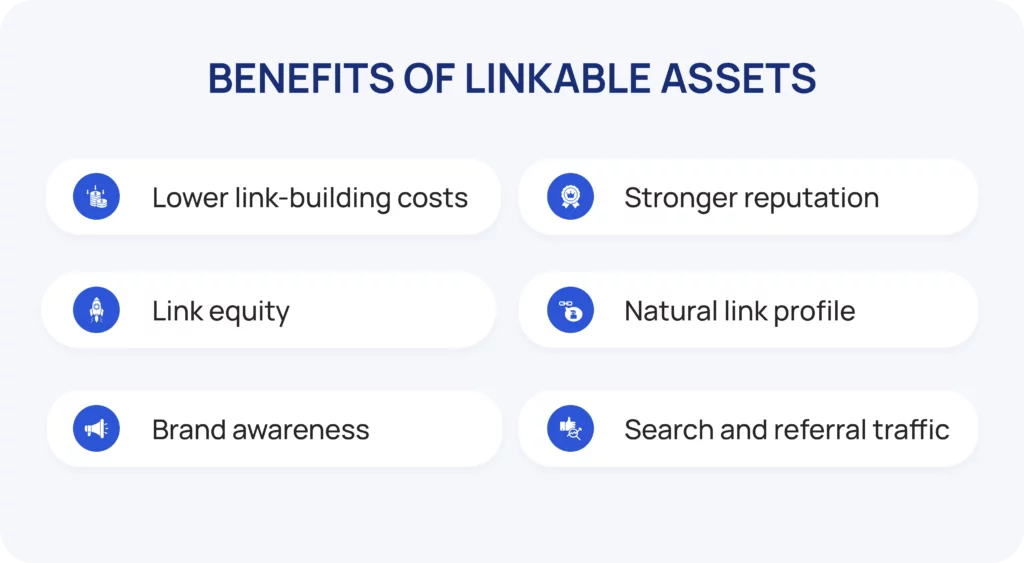
Lower link-building costs
A linkable asset dramatically boosts the ROI of your link-building efforts.
"But wait, isn't the whole point of linkable content that it attracts links naturally?"
If you aren’t HubSpot, everything you put on the web requires an initial push to gain visibility. But with a linkable asset, you’ll need to spend way less time and money promoting it.
For example, building 30 links to a regular page requires continuous research, outreach, and negotiation. Stop those efforts, and the links stop coming. When you have a link-worthy asset, you might only need to secure the initial 10 links directly, and the remaining 20 will accumulate organically over time.
Now, calculate the costs of acquiring the remaining 20 links through deliberate effort, and that's your saved budget right there.
Link equity
A single link-worthy page can boost the authority of your entire domain. And it’s not just about your site’s DR (or whatever metric you use).
As the asset attracts high-authority backlinks, it accumulates link equity, which it can then pass on to other important pages on your website through internal linking.
By thoughtfully linking from your link-worthy asset to other important pages (like product pages or targeted blog posts), you distribute the link equity, improving their visibility in search results.
Brand awareness
Although a linkable asset doesn’t necessarily go viral, it gives you greater exposure than any other content piece.
Every time it's shared, linked to, or referenced, your brand's name gets in front of new eyes within your niche.
In the AI Search era this is even more important because mentions on trusted sites raise the chance of your brand appearing in assistant answers.
Stronger reputation
Linkable assets pair extremely well with digital PR — they provide journalists and bloggers with valuable, newsworthy content to feature.
When a well-respected publication like MarketWatch (I like to think big) links to your guide, infographic, or research study, it lends credibility to your brand and drives targeted referral traffic.
Even if they’ve never heard about your brand, seeing a media giant link to your content will definitely boost your credibility in their eyes.
Natural link profile
Linkable assets contribute to a healthy, natural-looking backlink profile.
Since they attract links organically, the mix of referring websites appears diverse and authentic.
This is a positive signal to search engines, as it suggests your content is genuinely being shared and recommended by others, unlike a profile filled with only manually built or paid links.
Search and referral traffic
Of course, you'll naturally see improvements in search engine rankings for the asset itself and potentially other related pages on your site as your linkable asset earns backlinks and strengthens your overall domain authority.
And it only means one thing — your organic search traffic will grow.
As for referral traffic, while it heavily depends on multiple factors, it usually surges, too.
7 Linkable Asset Ideas
While literally any type of content can become a linkable asset, the following formats have the highest potential for attracting links.
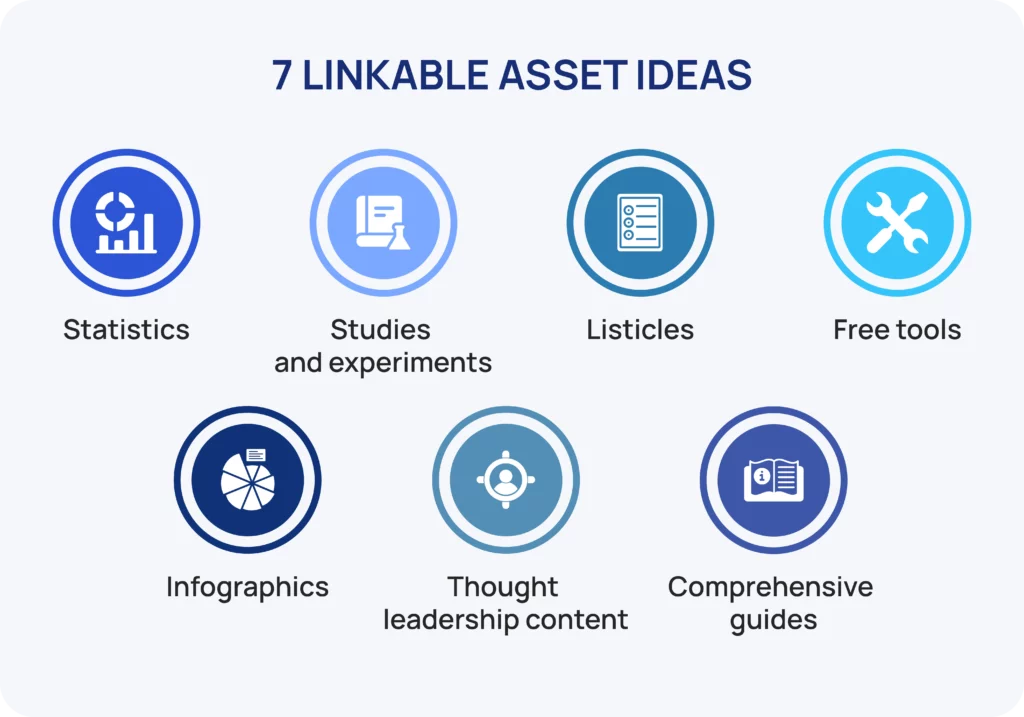
Statistics
I’ve personally seen statistics and data-related content work best for passive link earning & social buzz. Packing original research and data with visually appealing designs sets you up for long-term growth.
Original research and data-driven insights are like gold for bloggers and journalists.
They're always hunting for reliable statistics to back up their claims and make their content more credible.
For example, at Editorial.Link we’ve been running a survey and publishing link building statistics for the second year in a row.
It’s very expensive and it takes a lot of resources.
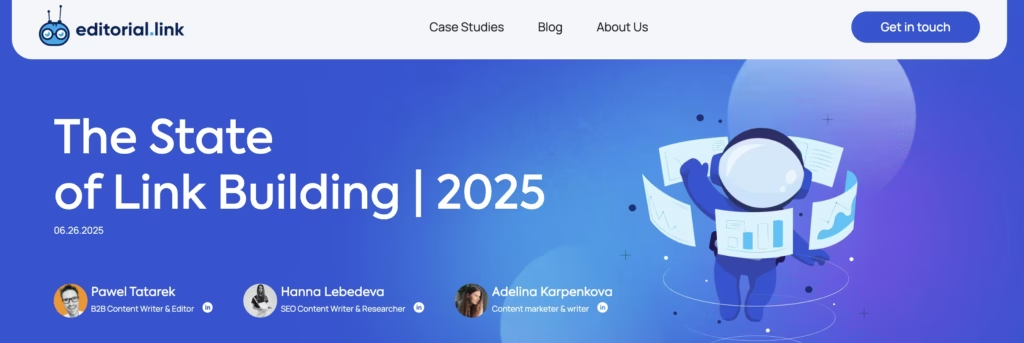
But it pays off in quality backlinks.
Our statistics page has been earning links for the second year without any active outreach.
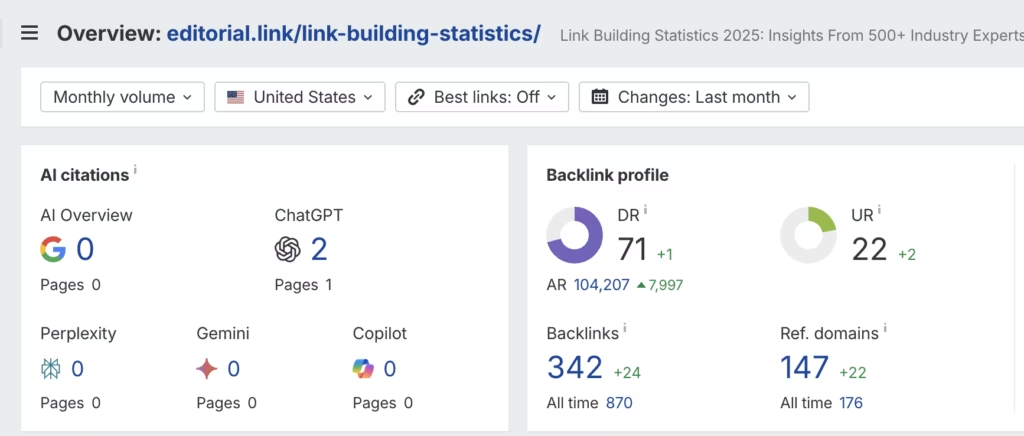
This makes stats-focused content one of the top choices for link building... but also one of the toughest to pull off for marketers and SEOs.
What if you don't have the resources to survey hundreds of people and create an original report?
You can still reap the benefits from this type of linkable asset.
Here's the trick — gather the freshest stats from various resources and compile them into the ultimate stat list.
Heads up: I strongly recommend that you always link back to the original sources. This boosts your credibility and gives credit where credit's due. And don't worry about people only linking to the original research – you'll be surprised how many will skip the extra clicks and link directly to your convenient roundup.
Interestingly, Google usually ranks stat roundups higher than original research. This likely reflects users’ love for this format.

Here’s an example of a client where we built a stats-based blog asset that now ranks #1 for its target keyword (“[industry] + stats”) and gets cited in content dozens of times each month.
We’ve done zero outreach for this post and it has generated nearly 𝟕𝟎𝟎 𝐫𝐞𝐟𝐞𝐫𝐫𝐢𝐧𝐠 𝐝𝐨𝐦𝐚𝐢𝐧𝐬 in about 4 years! It accounts for nearly a third of the site’s overall link profile.
The blog has more referring domains pointing to it than the home page.
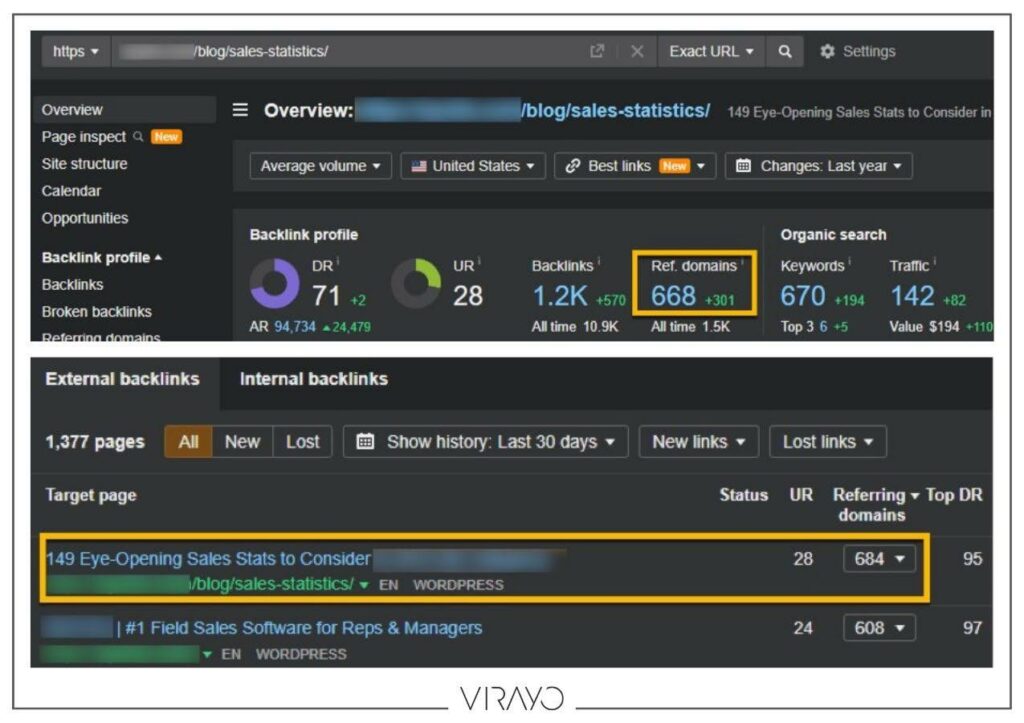
You can approach stat roundups in different ways. Zendesk, for example, presents statistics in concise bullet points for quick information.
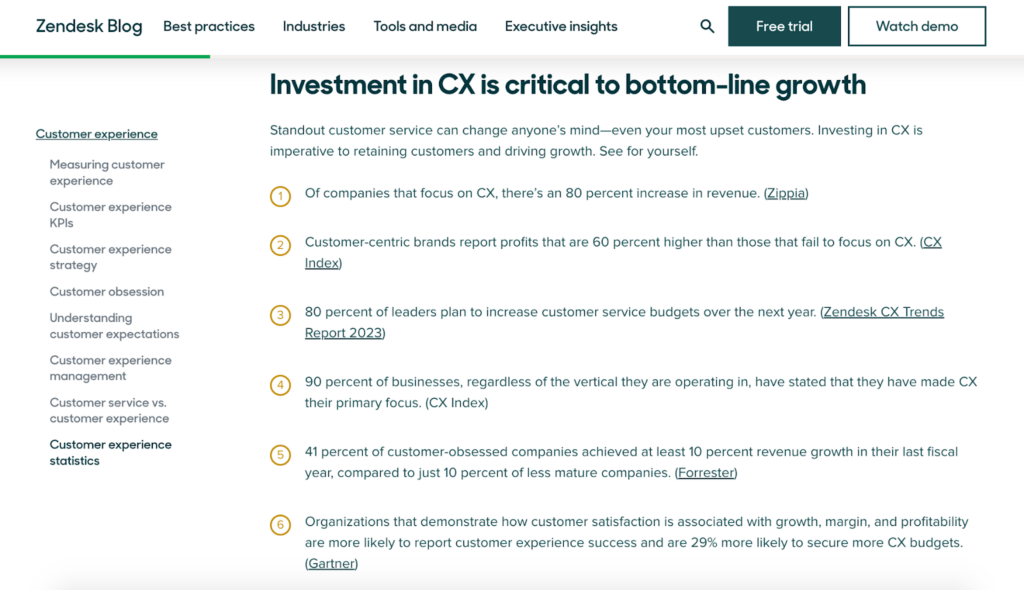
SuperOffice, on the other hand, expands on each stat, creating more in-depth articles that offer analysis and insights.

Studies and experiments
This is an incredibly resource-intensive content format, but it also has the highest potential to go viral.
Similar to statistics, studies and experiments offer unique insights no one else has. But the latter have a more hands-on, experimental approach. It may involve testing hypotheses, manipulating variables, and observing outcomes in a controlled environment.
Ahrefs put their own platform to good use, analyzing a massive 2 million featured snippets. What they found is still super relevant even after almost ten years. Most importantly, it continues to generate links all this time.

Listicles
Listicles are articles or blog posts that present information in a numbered or bulleted list format.
They tackle a wide range of topics, from the "Top 10 SEO Tips for Beginners" to "5 Must-Have Kitchen Gadgets for Busy Cooks."
People love listicles.
AI love listicles.
Google love listilces.
Desperately.
Whenever one needs a product they know nothing about, they'll start by searching for "best [category name]." They crave simple, curated lists offering the best solutions without the need for extensive research. That's the power of listicles – they provide answers in a quick, convenient format everyone loves.
So what makes site owners link to your listicles?
When you include someone's product, service, or website in your listicle, it creates a natural opportunity for outreach.
“Look, we’ve included your product in a list of best gifts for teenagers, and we’ll appreciate it if you link to it from your blog!”
It’s way easier to earn a link when your outreach message sounds like that. And once your listicle picks up on rankings, it will start generating links on autopilot… At least this is what happened to this list of the best SEO tools by HubSpot:

Free tools
Free, useful tools solve real-world problems. When people in your niche find your tool helpful, they'll spread the word through links, mentions, and social sharing. It's link-building on autopilot.
Many SaaS platforms use free tools (don’t confuse them with freemiums and free trials) as part of their marketing strategy. Moz offers a free Domain Authority checker:
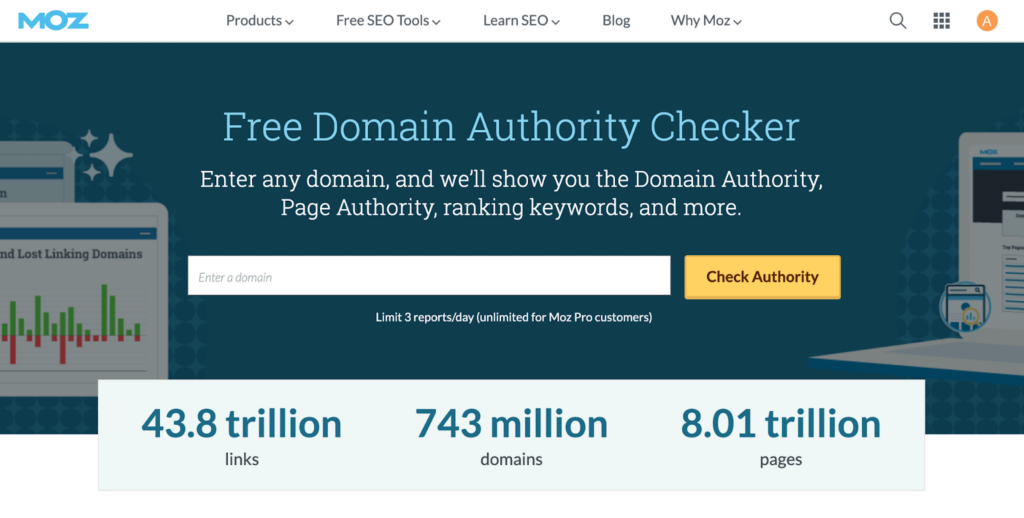
And while link-building might've been a secondary goal, the results were phenomenal.

However, developing a genuinely valuable tool requires time, money, and often coding skills. If you have the resources, it can be a massive long-term win. But what if you don't?
Don't overthink it. Even a well-designed calculator or a basic checklist can be link bait if it’s what your audience needs now.
This tax calculator by NerdWallet doesn’t require a complex algorithm:
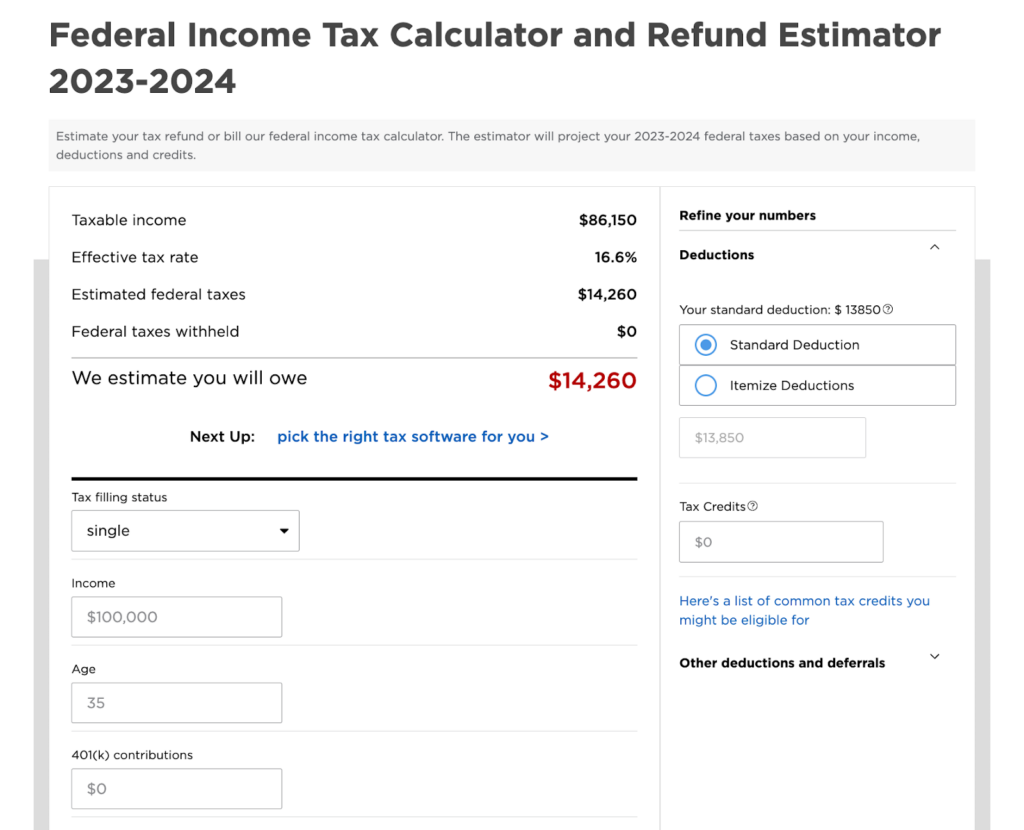
But it turned out to be a magnet for links:

Infographics
Lacking resources but need to create a linkable asset? Consider infographics.
Infographics make complex information digestible and visually appealing. They're loved on social media and blogs, making them prime linkbait — and probably the easiest type of linkable asset to create.
Years ago, Search Engine Land developed an infographic called “A Periodic Table of SEO Elements.”

The resource has earned a few thousand links and shows no signs of slowing down. The team continues to update it to keep the infographic relevant and linkable.

“But this is a leading SEO blog. They can build links to anything.” Probably you’re right. Yet you don’t have to be a media giant to earn organic links to your infographic.
I’m a big fan of original data and like to build links by conducting original research with surveys or examining existing data within a company and creating reports.
I prefer this because I love collecting and playing around with data. Also, data helps you create unique content that no one else can easily replicate.
An example is the infographic I created for my blog Social Marketing Writing. I created a survey, invited bloggers to participate, and made a simple infographic titled “How to Build a Credible Blog” from the results. It attracted over a hundred backlinks organically with minimal promotion.

Now, here's the thing: people love sharing infographics, but sometimes they forget (or neglect) to link back to the source. Include your brand name and a link to the site right in the infographic. This way, even without a formal link back, you'll still get valuable brand exposure every time it's shared.
Thought leadership content
This type of content is relatively easy to produce, but it’s also less likely to land you a ton of links than something like a killer study or free tool.
That said, you can still score links with smart thought leadership content.
Search Engine Journal excels at this technique. They take a juicy comment from an industry expert, add context, maybe a touch of analysis, and voilà — it's a full-fledged thought leadership article.
For instance, their article "Google's John Mueller: Technical SEO Is Not Going Away" built a whole piece around a single comment from Mueller.
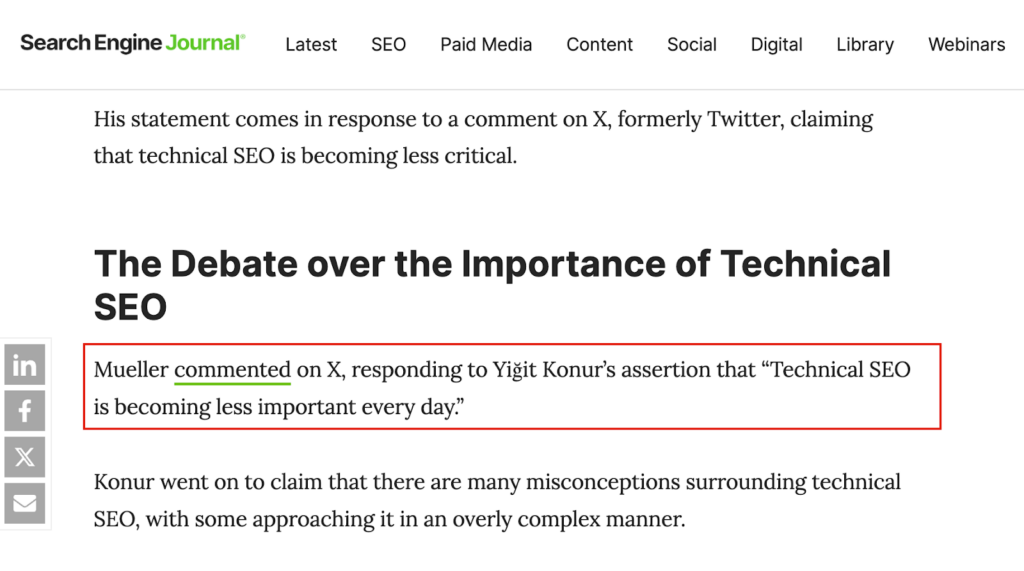
… which was enough to generate 147 links, including 45 links from unique domains.

Comprehensive guides
A comprehensive guide is a deep dive into a specific topic or area, providing all the essential answers a reader would need. It often targets broader keywords with high search volume, offering the kind of exhaustive information that makes a perfect reference point.
Chances are, you already have these guides on your blog, but they don't seem to attract many links. The likely reason is that you're not ranking well enough for your chosen keywords.
The challenge with comprehensive guides is that you need to put your content in front of your audience first. Once you're there, you can enjoy the links piling up organically.
So if you’re aiming for high-competition keywords, you won’t be able to rank well until you collect as many links as competing content has.
Instead, target niche or long-tail keywords with less competition. For instance, if I run a Facebook advertising agency, rather than pursuing the super-competitive "Facebook advertising" keyword, I’d focus on "Facebook retargeting” or other less competitive keywords.

By the way, Shopify’s Complete Guide to Facebook Retargeting is a great example of a linkable asset.

Update your guides regularly so that they keep fresh and continue to generate links. Include step-by-step instructions, checklists, or templates for people to use. This makes the guide a go-to source even after the initial research stage.
Don’t have time to create linkable assets?
Creating high-quality linkable assets is time-consuming, and even the best content often needs an initial outreach boost to gain traction. If building your link profile quickly is a priority, consider partnering with a reliable link-building agency Editorial.Link.
We at Editorial.Link specialize in securing high-quality backlinks that boost your rankings and drive lasting results.
Let’s talk about your project!




